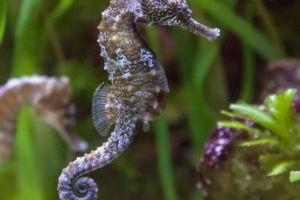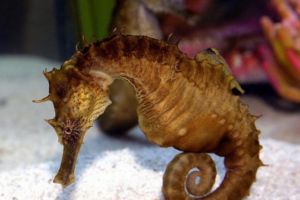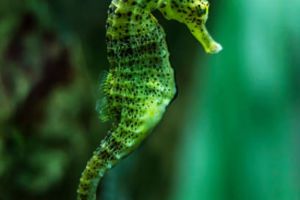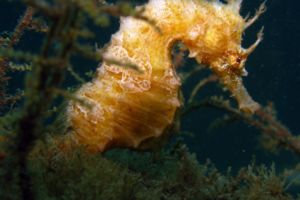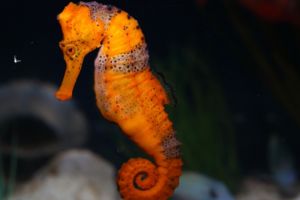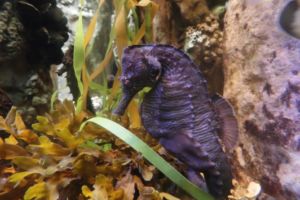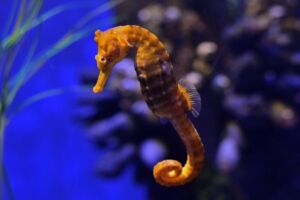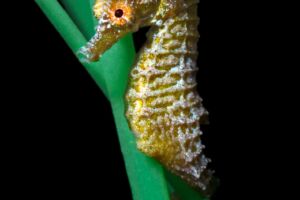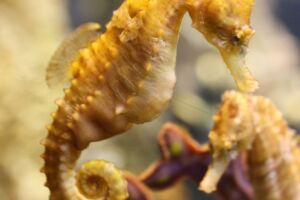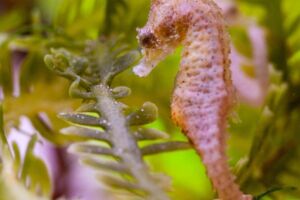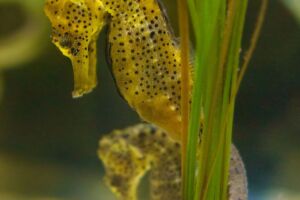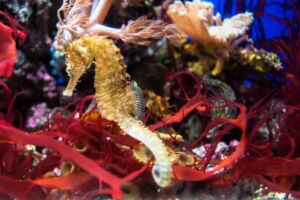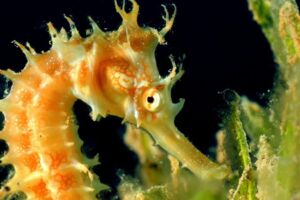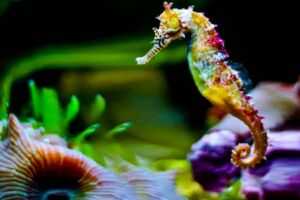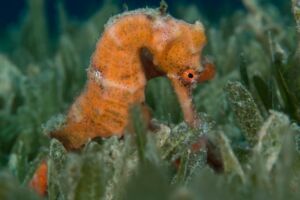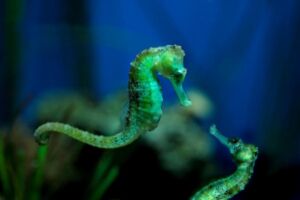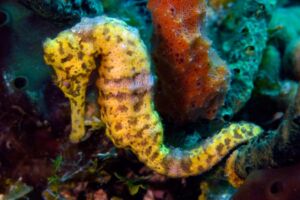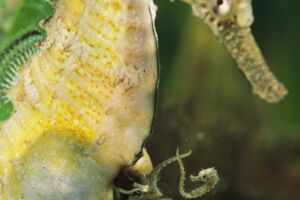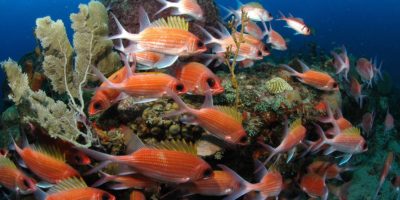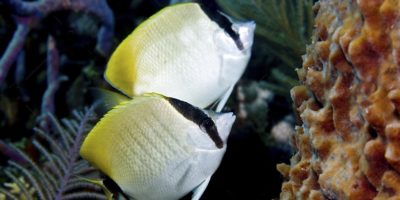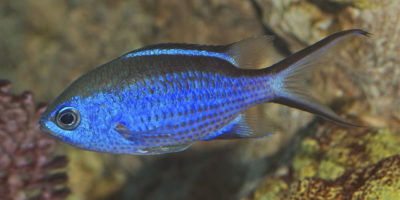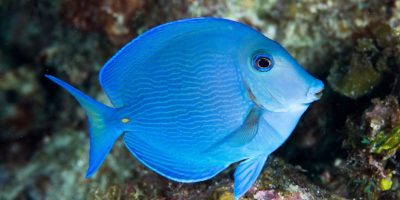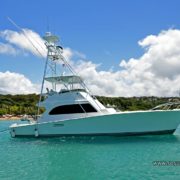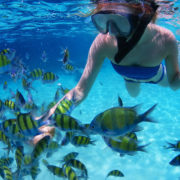Seahorses have, for over 2,000 years, captured the imagination and inspired all sorts of legends in many latitudes. Poseidon, the Greek god of the sea ( Neptune to the Romans), traveled in a chariot drawn by fierce seahorses with heads of a horse and tails of a fish.
Seahorses, one might imagine, are masterpieces of evolution, reaching their unique morphology and niche in the web of life through many twists and turns over millions of years. There are 32 distinct species, of which three are found in the Caribbean waters, The Lined Seahorse, Dwarf Seahorse and the Long Snout ( Slender ) Seahorse.
1) The Lined Seahorse:
The Lined Seahorse (Hippocampus erectus) is a diurnal species, found in many colors (grey, blacks, reds, green, oranges). It measures 15 cm (5.9 inches ) and its lifespan is 1-4 years. It swims in erect position, supported by its dorsal and pectoral fins. Males have bigger bodies, with longer tails. This species is monogamous, keeping the same partner for life, and only on rare cases finding a new partner if one of the two dies.
Photo Gallery:
Range & Habitat
The lined seahorse distribution spans Northern Nova Scotia, down to the Caribbean, and South America. They can also be found on the east coast of the USA and the waters surrounding Mexico. The island of Dominican Republic including Sosua`s reefs are abundant with seahorses.
Feeding Habits
The lined seahorse uses its long snout to eat its prey, and mainly feeds on tiny mollusks, zooplankton and crustaceans. It has been reported that captive parental males have been known to cannibalize some of its juveniles. Seahorses are masters of camouflage, changing color to blend with its surroundings.
Behavior & Reproduction
As in other seahorse species, the male fertilizes the eggs internally and gives birth to its offspring. After courtship, the female sprays her eggs into the male`s pouch where the eggs take about 3 weeks to incubate. When ready to hatch, the male will release the juveniles into the water column by arching his back and pushing out hundreds, if not thousands of newborns that measure about 11mm at birth.
Known Predators
The lined seahorse is prey to Rays, Seabirds, Sharks, Tuna, dolphinfish, crabs and skates. Even though they are good at camouflage, their slow swimming makes them an easy target for predators. This species is not considered endangered, though its habitat loss is of concern.
On Video
2) The Dwarf ( pygmy) Seahorse:
The Dwarf, also called pygmy seahorse (Hippocampus zosterae) is the smallest known species, a slow swimmer that moves at a speed of 5 feet per hour. It grows an average of 2 and 2.5 cm with a maximum length of 5.0cm and it can be found in various colors such as white, beige, green, yellow, and black.
Photo Gallery
Habitat
The Dwarf seahorse inhabits seagrass beds of bay and estuaries of the Atlantic Ocean, from Bermuda and the Caribbean and throughout the Gulf of Mexico. It is common to the reefs near Sosua Beach, often photographed by tourists in the top Sosua diving sites.
Diet
Due to their short digestive tract, these species must eat constantly. They prey on copepods and other small crustaceans. They also eat brine shrimp and shrimp larvae. They are ambush predators, sitting by the current waiting for the prey to swim by, then use their snout to suck prey in.
Behavior & Reproduction
Their courtship ritual involves color changing, while they attach to each other using their tails. These species also mate for life, so they are monogamous by nature. Dwarf seahorse, as other species are ovoviviparous, and the female releases about 55 eggs into the male`s brood pouch where he will fertilize and carry them until hatching and giving birth 11 days or so later.
The newborns will measure about 8mm in size. This species can live up to 2 years in captivity. It is not a species in danger of extinction though its loss of habitat is diminishing its numbers, this due to human development.
On Video
3) The Slender (long snout) Seahorse:
The slender seahorse or longsnout seahorse (Hippocampus reidi) is known for its slender body that can grow up to about 7 inches in length. As other species, they can have a wide variety of colors, including red, saffron, buttercup, ochre or mustard yellow, often with darker spots.
Photo Gallery
Range & Habitat
Longsnout seahorses inhabit the North Atlantic Ocean, the Caribbean Sea and Brazil. They are found in shallow waters from 0-180 feet, attached with their monkey-like tail to seagrasses, mangroves, gargonians and also among floating sargassum, oysters, sponges or man made structures such as piers. Females are considered to venture farther than males because the brood pouch the male uses to fertilize and carry the eggs decreases mobility. It is easy to find and photograph these slow swimmers in Sosua Beach or its main diving sites, just contact one of the Sosua diving centers.
Feeding Habits
This species feeds on almost the same as the other species, sucking plankton, small crustaceans and plants using his snout, preying as the food passes by. They feed during the day and rest at night.
Behavior & Reproduction
The longsnout seahorse reach sexual maturity at about 3 inches in size. They are also oviviparous, and have the same courtship ritual and breeding behavior as the other two Caribbean seahorses. They mate for life, and the male is the one to carry and fertilize the eggs deposited in his pouch by the female.
The color-changing, pouch inflating ritual is worth seeing, specially in captivity with good lighting. The eggs take about 15 days to hatch, then the miniature seahorses are born with a diameter of about 5.14 mm, really small. This species has a lifespan of 1-4 years.
On Video: Male giving birth
=
Sources:
- National Geographic – Seahorses
- Seahorses in myth, legends and art
- Wikipedia – Lined Seahorses
- Smithsonian Institute – Hippocampus Erectus
- National Geographic – Seahorses Myth
- Thoughco – Long Snout Seahorse


